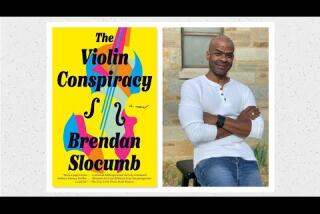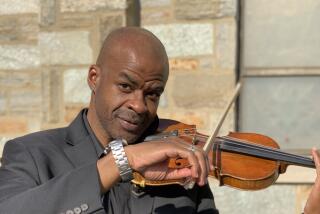‘The Lost Symbol’
The wait is over. “The Lost Symbol,” the follow-up to Dan Brown’s 2003 mega-seller, “The Da Vinci Code,” is here -- and you don’t have to be a Freemason to enjoy it (although it wouldn’t hurt).
Like “Angels and Demons,” published in 2000, and “The Da Vinci Code,” “The Lost Symbol” solves puzzles, analyzes paintings and reveals forgotten histories -- all so that Brown’s tireless hero, Robert Langdon, can find a legendary Masonic treasure despite special ops squads that are dogging him and a bizarre killer who has kidnapped his dear friend and mentor.
There is one mystery, though, that remains unsolved after three books.
Will Langdon ever get to rest?
You’d think a 46-year-old Harvard symbologist’s most strenuous chores would be grinding his Sumatran coffee beans in the morning or persuading bored undergrads to appreciate hidden meanings in the world around them. Langdon does these things, but he’s also the guy who survived an antimatter explosion at the Vatican and a Paris manhunt and uncovered the truth about the Holy Grail (though, according to the new novel, he’s kept this a secret). Not your average academic.
The answer, then, to the question of rest is clearly no. Langdon, after all, specializes in what all esoteric evildoers need: rituals and their transcendent meanings. He finds crucial connections that other people can’t see, even in the most difficult, chaotic situations.
Consider an early incident in “The Lost Symbol,” a scene that is as gruesome and allusive as the opening of “The Da Vinci Code” (in which a dying, blood-covered curator in the Louvre arranged his body into a puzzle).
Langdon arrives in Washington D.C., invited by his wealthy friend Peter Solomon, a high-ranking Mason, to deliver a speech in the Capitol building. The moment he enters the rotunda, however, Langdon discovers there is no speech. The “invitation” has been faked by an individual who wants our hero to find something that has been conspicuously positioned -- a severed hand (Solomon’s), marked with Masonic tattoos and propped to point to an 1865 painting of George Washington depicted as a pagan god. As horrific as this is, Langdon recognizes that the grisly object resembles something called “the Hand of the Mysteries.”
“[I]t seems the man we are dealing with, in addition to being mentally unstable, is also highly educated,” Langdon says. “This hand is proof that he is well versed in the Mysteries as well as their code of secrecy. . . . the Hand of the Mysteries is a sacred invitation . . . “
That educated, unstable person calls himself Mal’akh (“angel” in Hebrew), and in him Brown gives us a villain as unique, zealous and eerie as the albino monk Silas in “Code.” Mal’akh is a muscled, tattooed eunuch -- a chameleon-like figure who seeks a hidden Masonic pyramid because, the legend goes, it contains the power of transformation (a common quest, Brown reminds us, in the ancient world). It seems Mal’akh gained the trust not only of Peter but also of Peter’s sister Katherine, a scientist through whom Brown introduces the theme of science versus magic -- not to mention the possibility that a wedding might be in Langdon’s future.
Like the “cryptex” in “Da Vinci Code,” an antique object aids Langdon and Katherine on a hunt across -- and beneath -- the city, a hunt in which they are helped -- and hindered -- by characters including the blind dean of Washington’s National Cathedral and the gnomic director of the CIA’s Office of Security, Inoue Sato (don’t mess with her).
All of this is going to feel very familiar to readers of the previous Langdon books, even though Brown has shifted from foreign places to plant his thriller firmly on American soil. That, of course, is fine for Langdon: He finds this country’s past as rich and mysterious as any other’s. “Seriously,” he tells his students, “Washington, D.C., has some of the world’s finest architecture, art and symbolism. Why would you go overseas before visiting your own capital?”
Why, indeed. Some people believe Freemasonry’s origins in medieval craft guilds include a darker, conspiratorial side. Historians point out that the secrecy of Scottish Rite Freemasonry, in particular, has led to its being the least understood of Masonry’s variants -- a situation Brown exploits to the fullest with depictions of occult ceremonies.
Hidden knowledge takes many shapes in “The Lost Symbol.” Alchemists, Egyptians and rabbi sages are invoked; so are the U.S. government’s eavesdropping tactics in the war on terror, superstring theory and the New Agey-sounding study of noetics, which Katherine believes one day will enable the mind to bring about real changes in the physical world.
Brown’s narrative moves rapidly, except for those clunky moments when people sound like encyclopedias (“The sacred symbol of the Hebrews is the Jewish star -- the Seal of Solomon -- an important symbol to the Masons!”). But no one reads Brown for style, right? The reason we read Dan Brown is to see what happens to Langdon: We want to know if he will overcome slim odds to uncover Mal’akh’s motives and a cunning plan that, while not involving a vial of antimatter, is a major threat to national security.
And yet, it’s hard to imagine anyone, after reading “The Lost Symbol,” debating about Freemasonry in Washington, D.C., the way people did Brown’s radical vision of Jesus and Mary Magdalene in “Code.” That book hit a deep cultural nerve for obvious reasons; “The Lost Symbol” is more like the experience on any roller coaster -- thrilling, entertaining and then it’s over.
More to Read
The biggest entertainment stories
Get our big stories about Hollywood, film, television, music, arts, culture and more right in your inbox as soon as they publish.
You may occasionally receive promotional content from the Los Angeles Times.










